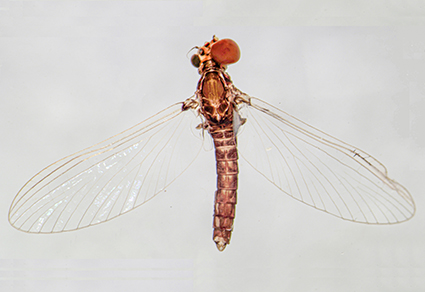Abstract
Previously there were only three cases of mayfly gynandromorphism reported from Asia, occurring in the families Baetidae and Heptageniidae. Here, we report two intersex individuals of Choroterpes facialis (Gillies, 1951) (Ephemeroptera: Leptophlebiidae) from southeastern China. They have similar external morphologies (each having two different eyes, two shortened penes, and female sternum IX) but with one being predominately male and the other being predominately female (one with eggs in the abdomen, but the other apparently with sperm). We believe this to be the first report of a feminized male individual. This phenomenon implies their intersexuality is caused by some similar reasons, such as temperature or parasitism. Remarkably, two intersex specimens found among 1,736 normal individuals shows that gynandromorphism does occur rarely, and only six normal males in the sampling suggest the species C. facialis is partially parthenogenetic at least.
References
Braasch, D. (1984) Beitrag zur Kenntnis der Heptageniidae des Himalaya II Ephemeroptera. Reichenbachia, 22, 45–50.
Eaton, A.E. (1881) An announcement of new genera of the Ephemeridae. Entomologist’s Monthly Magazine, 17, 21–27, 191–197.
Funk, D.H., Sweeney, B.W., & Jackson, J.K. (2010) Why stream mayflies can reproduce without males but remain bisexual: a case of lost genetic variation. Journal of the North American Benthological Society, 29, 1258–1266. https://doi.org/10.1899/10-015.1
Gillies, M.T. (1951) Further notes on Ephemeroptera from India and South East Asia. Proceedings of the Royal Society of London (B), 20, 121–130. https://doi.org/10.1111/j.1365-3113.1951.tb01009.x
Grant, P.M. & Masteller, E.C. (1987) Intersexuality in Ephemeroptera: description of four specimens and comments on its occurrence in a parthenogenetic species. Canadian Journal of Zoology, 65, 1985–1988.https://doi.org/10.1139/z87-302
Keffermüller, M. (1960) Investigations on the fauna of Ephemeroptera in great Poland. Publications of the section of biology (The Poznań society of friends of science), 19, 411–467. [in Polish]
Kimmins, D.E. (1937) Some new Ephemeroptera. Annals and Magazine of Natural History, Series 10, 19 (112), 430–440.https://doi.org/10.1080/00222933708655283
Kluge, N.J. (2015) Central Asian mountain Rhithrogenini (Ephemeroptera: Heptageniidae) with pointed and ephemeropteroid claws in the winged stages. Zootaxa, 3994 (3), 301–353. https://doi.org/10.11646/zootaxa.3994.3.1
Lestage, J.A. (1917) Contribution l’etude des larves d’Ephemeres palearctiques (Series 1). Annales de Biologie Lacustre, 8, 213–457.
Lestage, J.A. (1922) Deux cas de tératolgie: chez une larve de Perla abdominalis Burm. (Plécoptère) et chez une femelle adulte de Baetis rhodani Pictet (Éphémère). Annales de Biologie Lacustre, 11, 85–87.
Lestage, J.A. (1924) Les Ephémères de l’Afrique du Sud. Catalogue critique & systematique des espèces connues et description de trios genres nouveaux et de sept espèces nouvelles. Revue zoologique Africaine, 12, 316–352.
McCafferty, W.P. & Bloodgood, D.W. (1986) Gynandromorphism and differential molting in a mayfly (Ephemeroptera). Entomological News, 97, 57–60.
Nascimento, J.M.C.D., Castelaci, L.C. & Hamada, N. (2021) More about Thraulodes Ulmer, 1920 (Ephemeroptera: Leptophlebiidae) from the Brazilian Amazonia: three new species, a new record and a gynandromorph report. Zootaxa, 5076 (1), 21–38. https://doi.org/10.11646/zootaxa.5076.1.5
Peters, W.L. (1971) A revision of the Leptophlebiidae of the West Indies (Ephemeroptera). Smithsonian Contributions to Zoology, 62, 1–48.https://doi.org/10.5479/si.00810282.62
Pohe, S.R. (2019) Macroecology of New Zealand Ephemeroptera. PhD. Dissertation, University of Canterbury, Christchurch, 226 pp.
Santos, R.P., Moreto, V. & Mariano, R. (2019) Intersexuality in Farrodes Peters, 1971 (Ephemeroptera: Leptophlebiidae: Atalophlebiinae) from Brazil. Revista Brasileira de Entomologia, 63, 202–204.https://doi.org/10.1016/j.rbe.2019.05.008
Soldán, T. & Landa, V. (1981) Gynandromorphism, intersexuality and teratology of external genitalia in the order Ephemeroptera. Věstník Československé Společnosti Zoologické, 45, 189–203.
Ulmer, G. (1919–1920) Neue Ephemeropteren. Archiv für Naturgeschichte (A), 85 (11), 1–80.
Westwood, J.O. (1840) An introduction to the modern classification of insects, founded on the natural habits and corresponding organization of the different families. Longman Co., London, xi + 587 pp., 133 figs.https://doi.org/10.5962/bhl.title.12455
Williamson, H. (1802) On the Ephoron leukon, usually called the white fly of Passaick River. Transactions of the American Philosophical Society, 5, 1–73.https://doi.org/10.2307/1004977
Wu, X.Y., Gui, H. & Su, C.R. (1993) On the first mayfly gynandromorph described in China. Acta Zootaxonomica Sinica, 36, 382–384. [in Chinese]
Zhang, W., Lei, Z.M., Li, W.J. & Zhou, C.F. (2021) A contribution to the genus Afronurus Lestage, 1924 in China (Ephemeroptera: Heptageniidae, Ecdyonurinae). European Journal of Taxonomy, 767, 94–116. https://doi.org/10.5852/ejt.2021.767.1491
Zhou, C.F. (2006) The status of Cryptopenella Gillies, with description of a new species from southwestern China (Ephemeroptera: Leptophlebiidae). Oriental Insects, 40, 295–302.https://doi.org/10.1080/00305316.2006.10417483


